Grajewo Now and Then
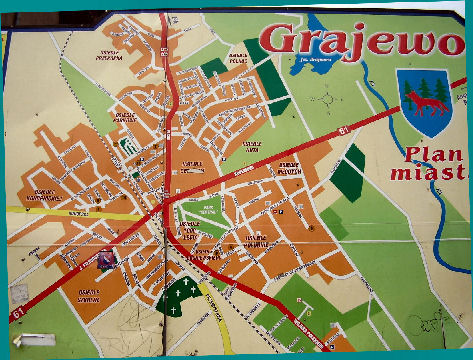 Situated at an intersection of two important
roads, from Warsaw to Vilnius (route No 61) and from Elk (in former
Prussia) to Bialystok, Grajewo managed to become a vivid center of
trade and communication. The central place was a square market with a
dominating neo-gothic church, surrounded by solid two-storey
buildings, where all wealthy families lived (among them many Jewish).
There were also shops and work places for about 170 handworkers, of
which the majority belonged to Jews. The market was not only a place
where every-day life took place but also all local events such as
military parades, as the 9th regiment of the cavalry had its
headquarters in town. Thousands of travelers, traders, clerks,
officers, and soldiers helped to keep a good level of prosperity which
can be observed even today looking at the remaining buildings.
Situated at an intersection of two important
roads, from Warsaw to Vilnius (route No 61) and from Elk (in former
Prussia) to Bialystok, Grajewo managed to become a vivid center of
trade and communication. The central place was a square market with a
dominating neo-gothic church, surrounded by solid two-storey
buildings, where all wealthy families lived (among them many Jewish).
There were also shops and work places for about 170 handworkers, of
which the majority belonged to Jews. The market was not only a place
where every-day life took place but also all local events such as
military parades, as the 9th regiment of the cavalry had its
headquarters in town. Thousands of travelers, traders, clerks,
officers, and soldiers helped to keep a good level of prosperity which
can be observed even today looking at the remaining buildings.
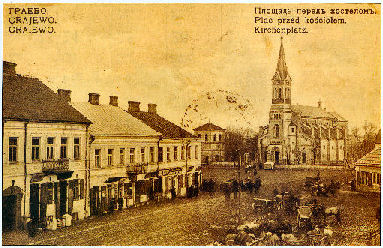 The street towards Szczuczyn was called
Szczuczynska (now Pilsudskiego Street); the other one towards Rajgrod
was called Rajgrodzka (now Kopernika). The former Boguszowska was
named after the village of Bogusze in the north, which was a border
with Prussia (with a city of Elk behind which gave it its current name
of Elcka) just several miles away. From this direction, the German
army attacked Grajewo on 1 September 1939 and conquered Grajewo within
hours.
The street towards Szczuczyn was called
Szczuczynska (now Pilsudskiego Street); the other one towards Rajgrod
was called Rajgrodzka (now Kopernika). The former Boguszowska was
named after the village of Bogusze in the north, which was a border
with Prussia (with a city of Elk behind which gave it its current name
of Elcka) just several miles away. From this direction, the German
army attacked Grajewo on 1 September 1939 and conquered Grajewo within
hours.
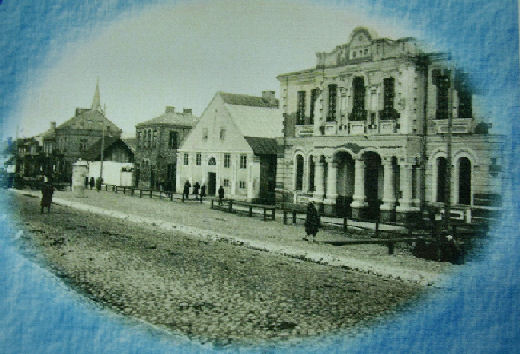 Although there were no bigger clashes, the Nazis destroyed the
synagogue on in the first days of WWII. This elegant building, a
religious site for almost 3,000 Jews, was situated on Rudzka Street
(now Wojska Polskiego) leading towards Bialystok. Interestingly
enough, when the Red Army took over the eastern part of Poland on 17
Septemeber 1939, the Soviets rebuilt the synagogue soon afterwards.
Although there were no bigger clashes, the Nazis destroyed the
synagogue on in the first days of WWII. This elegant building, a
religious site for almost 3,000 Jews, was situated on Rudzka Street
(now Wojska Polskiego) leading towards Bialystok. Interestingly
enough, when the Red Army took over the eastern part of Poland on 17
Septemeber 1939, the Soviets rebuilt the synagogue soon afterwards.
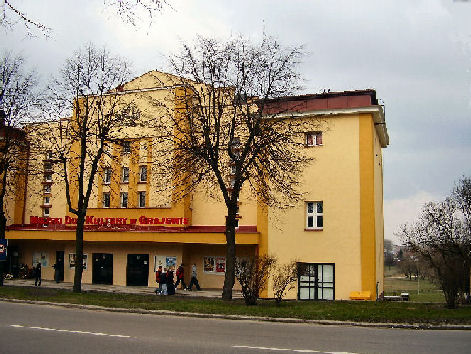 From the very beginning the former synagogue
served as a theater and has kept this function until today as a House
of Culture (and a movie theater).
From the very beginning the former synagogue
served as a theater and has kept this function until today as a House
of Culture (and a movie theater).
Around the synagogue, a poorer part of Jewish
inhabitants lived. Behind the pretty building, which stood on a hill,
the Jewish cemetery was located. The Nazis destroyed it completely,
however, so nothing is left today. Only very seldom today’s
inhabitants can find small fragments of matzevot and usually bring
them to Mr. Dudzinski, a young historian, who arranged in April 2008 a
small exhibition using a few available artifacts and plenty of
photographs.
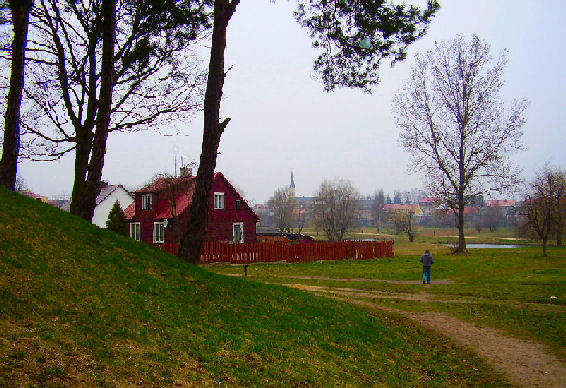 When you walk trough Grajewo nowadays, nothing
reminds you of the Jewish past, but Mr. Dudzinski knows the city very
well and is able to show you many interesting old places, such as the
former mikve, which used to be behind the synagogue. The old name of
this street was Lazienna (Bath Street).
When you walk trough Grajewo nowadays, nothing
reminds you of the Jewish past, but Mr. Dudzinski knows the city very
well and is able to show you many interesting old places, such as the
former mikve, which used to be behind the synagogue. The old name of
this street was Lazienna (Bath Street).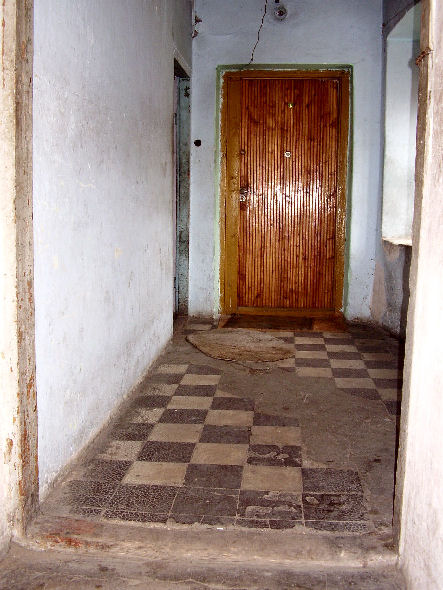

Not far from this was the ghetto, established by
the Nazis in August 1941, where 4,500 Jews were rounded up from
Grajewo and surroundings. The ghetto was liquidated in September 1942
and its inhabitants murdered in Treblinka. Today only a few buildings
remain there, some of them in extremely poor condition, desolated and
empty.
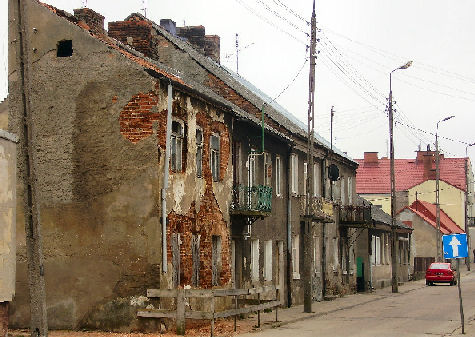
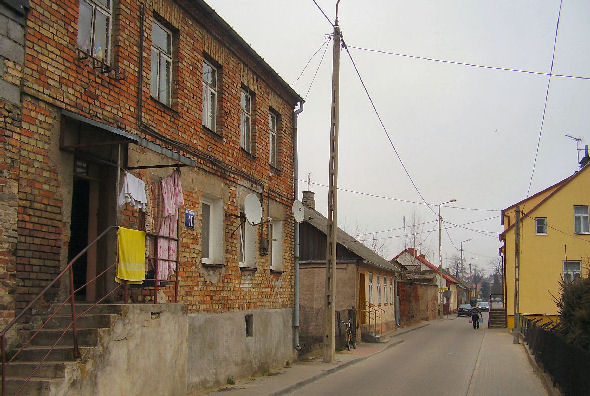
The collection of old postcards from Grajewo
exists thanks to German soldiers who took these pictures about 1910.
The longest street, Boguszowska, lead towards the boarder with
Prussia. A small building of cheder from this street survived until
these days.
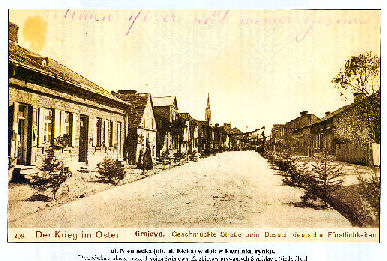
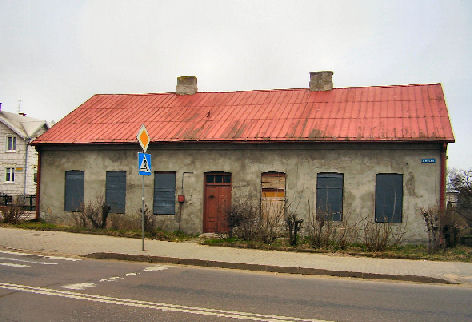
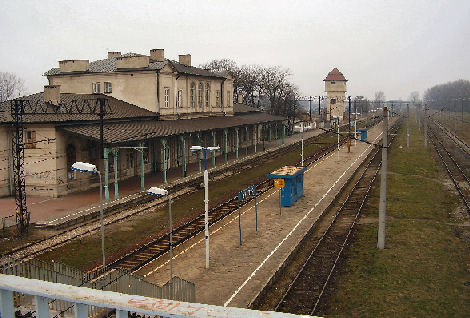 Private cars and busses have nowadays taken over
the once important railway route. So the Grajewo station looks like a
ghost town. In this area before WWII, there was a very elegant
restaurant “Paris” and many hotels, a park and children’s playground
and concerts of the military band.
Private cars and busses have nowadays taken over
the once important railway route. So the Grajewo station looks like a
ghost town. In this area before WWII, there was a very elegant
restaurant “Paris” and many hotels, a park and children’s playground
and concerts of the military band.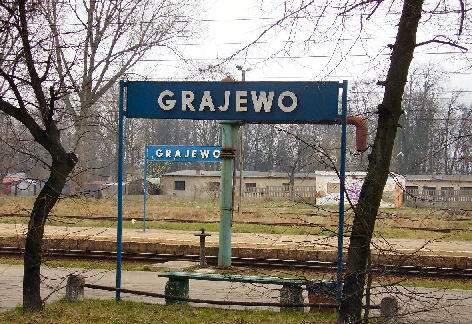
Grajewo is a quiet town today. Its previous
important role as an administration center has waned. Its inhabitants
suffer from unempleyment and a weak economy. Old buildings are falling
apart, the quite glorious history of the shtetl is forgotten. Almost.
Andrzej Selerowicz – text and pictures, April
2008.

